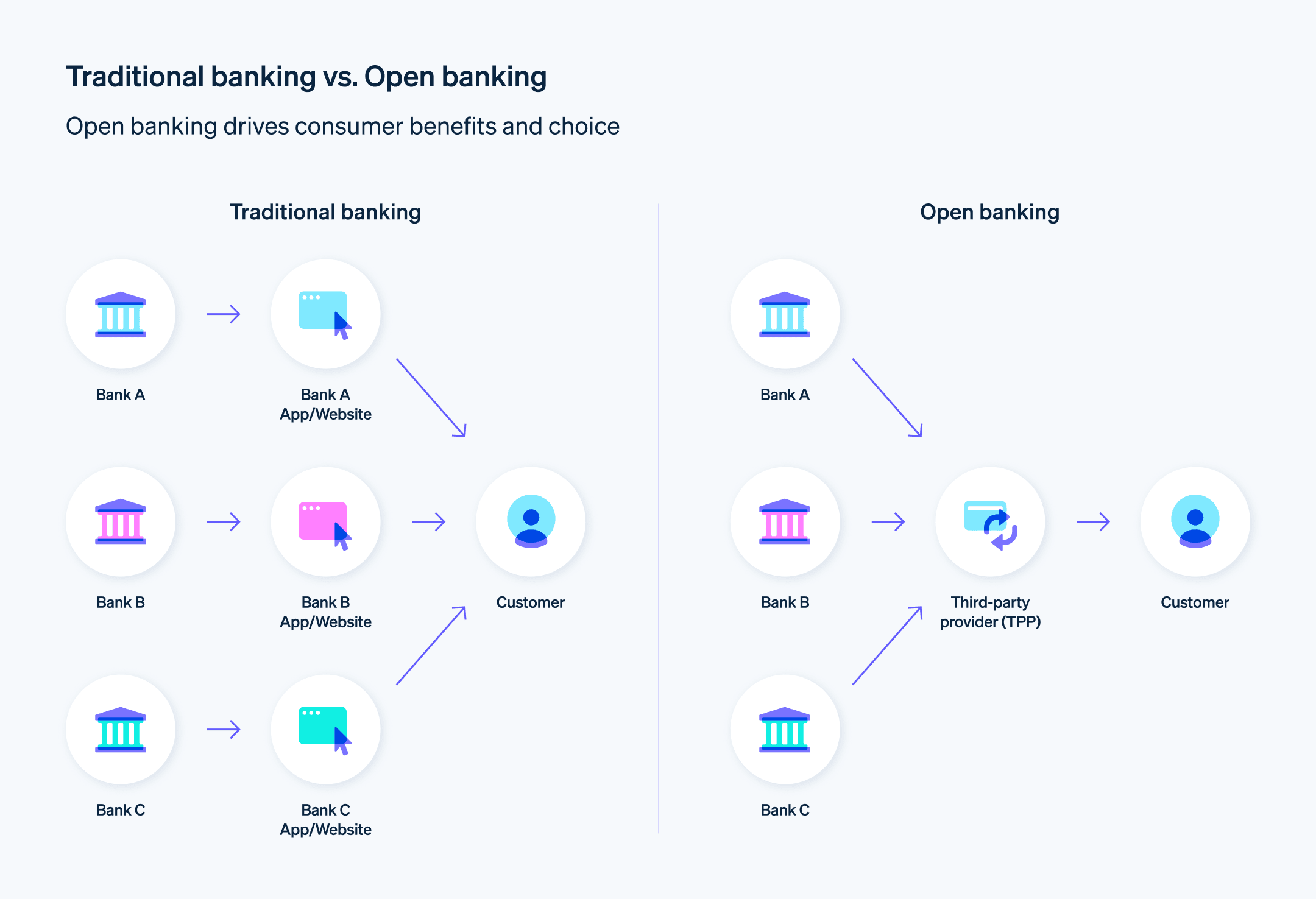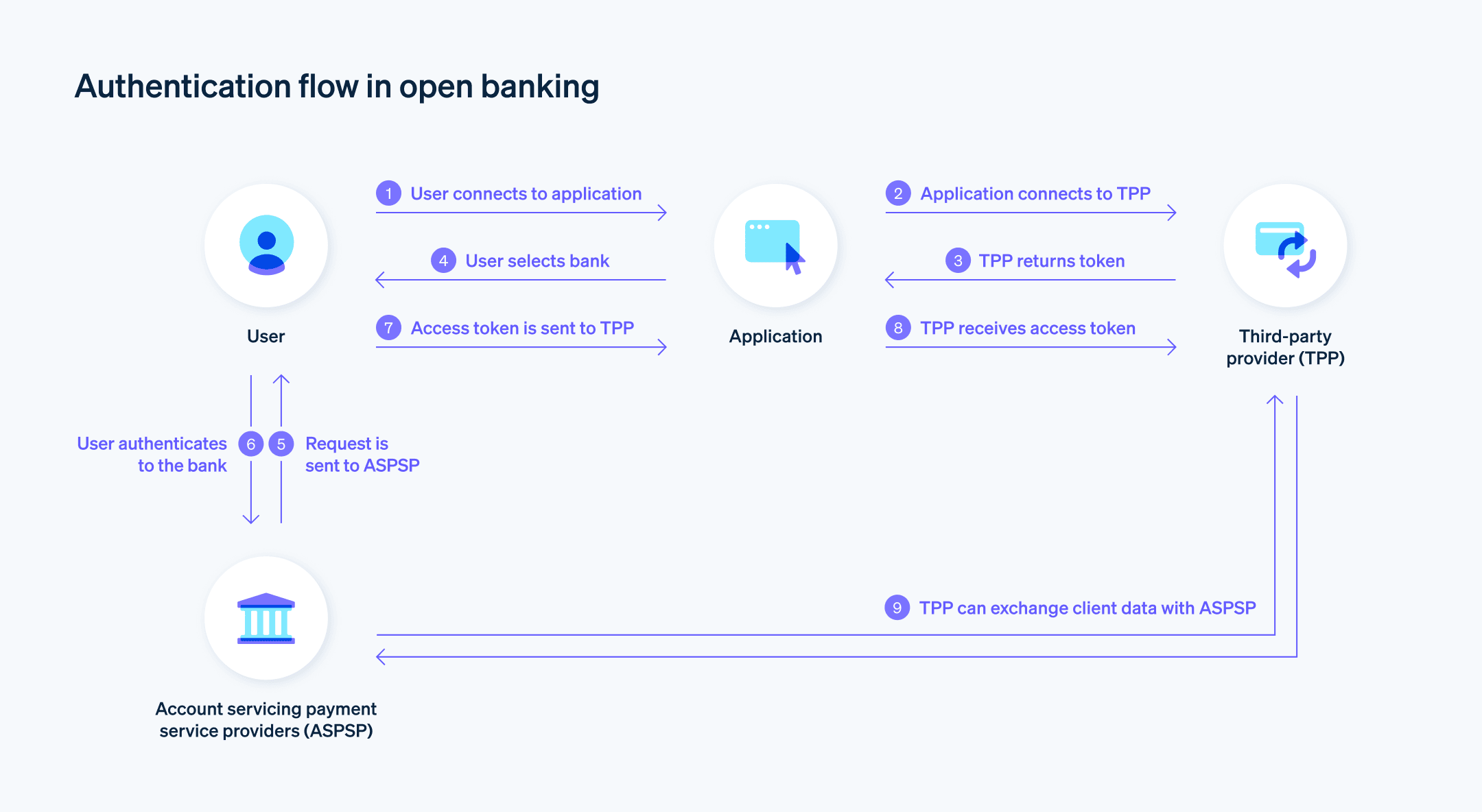如今,公司常常面临着缓慢且分散的金融系统带来的困扰,这些系统可能会限制对实时数据的访问,延误交易,并使集成变得复杂。另一方面,客户则要求更快、无缝的体验,而传统的基础设施和封闭网络往往缺乏这些。
开放式银行正在改变金融服务行业,为重新定义企业和金融机构互动方式的创新铺平道路。通过实现对金融数据的安全访问,它使企业能够简化支付流程,改善金融决策,并提供更具创新性的服务。
一份 2023 年瞻博研究报告预测,到 2027 年,全球开放式银行支付交易价值将超过 3300 亿美元。金融服务市场正在从孤立的运营过渡到更加互联互通的环境,金融机构和科技公司共同努力提供更广泛的服务。
然而,采用开放式银行仍然很复杂 — 数据隐私问题、安全风险以及不一致的监管框架带来了企业必须认真考虑的挑战。
以下是您需要了解的关于开放式银行的信息,包括它是如何运作的、它的好处,以及需要考虑的挑战。
本文内容
- 什么是开放式银行?
- 开放式银行如何运作?
- 开放式银行服务的 8 个示例
- 哪些人会使用开放式银行?
- 开放式银行的好处
- 开放式银行的挑战
- Stripe Financial Connections 如何提供帮助
什么是开放式银行?
开放式银行是一种金融服务模式,它允许第三方服务提供商通过应用程序编程接口 (API),从传统银行系统中访问消费者数据。这种模式通过提高透明度、增强竞争和促进创新,彻底改变了金融数据的共享和访问方式。
开放式银行可以让消费者更好地控制他们的财务信息,并提供新的服务和应用程序。它使企业能够获取实时金融数据,帮助它们简化支付服务、优化银行产品并改善客户账户管理。对于非金融公司来说,这种转变意味着它们能够为客户提供定制化的金融服务,做出更多基于数据的决策,并在支付和账户管理方面进行创新。随着对金融数据的更好访问,企业还可以简化支付流程并创造新的收入来源。
随着开放式银行计划和合规要求的不断增加,例如欧盟的《支付服务指令》(PSD2),企业正在利用开放式银行提供更安全、高效和个性化的金融体验。

开放式银行如何运作?
在传统的银行业务中,数据往往被孤立地保存在各个机构内部,这使得外部应用程序很难直接与金融账户进行交互。开放式银行业务通过强制执行标准化数据格式和安全通信协议,打破了这一局面。这就创造了一个公平竞争的环境,第三方服务可以在一套共同的规则、法规和技术标准下与多家银行集成。
开放式银行通过允许第三方服务提供商通过应用程序编程接口 (API) 安全地访问客户数据,实现了可互操作的金融服务。这些 API 为银行与授权第三方提供商之间安全交换金融信息提供了便利。
开放式银行中的 API 通常分为三种主要类型:
数据 API: 提供对账户信息、余额和交易历史的只读访问权限。
交易 API: 支持资金转账、直接借记和支付服务。
产品 API: 允许第三方列出金融产品、利率和条款。它们通常用于比较网站或市场。
开放式银行业务打破了数据壁垒,实现了平台之间的互操作性,可为企业提供更精细的数据洞察力和更广泛的金融服务选择,从而加速金融服务行业的创新。

开放式银行服务的 8 个示例
开放式银行不是一个独立的产品或服务。相反,它是一个框架,在此框架内可以提供各种金融服务。这个框架允许第三方服务提供商、银行应用程序和其他金融机构创建创新的金融服务,从而提高效率、安全性和客户体验。
随着开放式银行计划的不断发展,预计推向市场的金融服务范围将不断扩大。以下是目前使用开放式银行的一些方式:
支付发起服务: 零售商可以直接从客户的银行账户发起支付,无需使用传统的支付网关。这种方式可以实现更快的结算、降低交易费用并提高安全性。
账户聚合: 财务顾问和财富管理公司可以从多个账户中提取数据,从而更全面地了解客户的财务状况。这有助于进行更准确的财务规划和提供个性化的建议。
自动化预算: 企业可以为员工提供一个智能费用管理系统,该系统可以自动对多个银行账户的支出进行分类和跟踪。这一功能可以改善财务报告和预算管理。
即时贷款和信用评分: 金融机构和贷款机构可以从开放金融应用程序编程接口 (API) 获取实时消费者数据,以更准确地评估信用,加快贷款审批流程。
自动发票对账: 企业可以使用开放式银行 API 将发票与交易的匹配过程自动化,从而减少管理工作并提高准确性。这可以最大限度地减少管理工作、减少错误并改善现金流管理。
综合金融平台: 在多个市场运营的公司可以将不同银行的账户合并到一个管理中心中,从而更容易监控全球业务。
个性化营销: 零售商可以分析交易数据,以提供与个人消费习惯直接相关的定向促销活动或忠诚度奖励。
实时欺诈检测: 通过即时分析交易数据,企业可以比以往更快地发现异常活动,从而降低财务损失风险。
虽然这些例子只是可能的开始,但它们让我们得以一窥开放式银行如何改变金融服务业。随着法规和市场驱动的计划不断发展,第三方服务提供商和其他金融机构正在探索更新的可能性。
哪些人使用开放式银行?
开放式银行彻底重塑了企业、金融服务提供商和客户访问和使用金融数据的方式。在开放式银行框架内,有新的金融服务几乎可以满足每个客户和企业对企业 (B2B) 细分市场的需求。以下是一些正在使用开放式银行计划的群体:
个人客户: 客户通过第三方应用程序使用开放式银行来获取广泛的金融服务。他们可以查看自己的支出模式,获得高度个性化的财务建议,或自动执行账单支付等交易。
金融机构: 传统银行、信用社和其他金融服务提供商使用开放式银行来使其产品现代化,并创造更好的客户体验。他们还与较小的科技公司合作,将创新服务推向市场。
金融科技公司: 较新的、以技术为重点的公司利用开放式银行的安全数据共享功能来创建专业服务。这些范围从预算应用程序到复杂的企业财务管理解决方案。
中小型企业 (SMB): 这些组织使用开放式银行来自动化各种任务,例如将发票对账与银行交易相匹配,并更清楚地了解他们的财务状况。
监管机构: 制定和执行金融规则的组织发现开放式银行对于创建一个标准化的环境很有用。这有助于保护客户并确保金融服务行业内的安全数据处理实践。
电子商务公司: 在线销售产品或服务的企业可以更直接地处理交易,往往可以绕过传统的支付系统,降低成本。
会计平台: 财务软件可以访问实时交易数据,使账户管理更容易,并减少手动输入数据的需要。
软件开发人员: 有了开放式银行 API,软件开发人员可以为个人客户和企业创建一系列有益的服务和工具,为创新开辟新的途径。
信贷和贷款机构: 这些实体可以通过快速获取财务数据、优化贷款拨备和信用评分程序,做出更快、更准确的决策。
开放式银行正在金融领域掀起一股新的创新浪潮,允许第三方服务提供商创建能够提高数据安全性、效率和可及性的银行产品。随着开放式银行法规的不断发展,金融生态系统将变得更加互联互通,使客户和企业都受益。
开放式银行的好处
开放式银行为企业提供了各种机会来改善运营,更轻松地遵守法规,并提供增值服务,从而有效地为未来做好准备。以下是企业如何从开放式银行业务中获益:
数据驱动的决策: 开放式银行业务使企业能够获得详细的财务数据,从而为从风险评估到投资规划的战略选择提供依据。在评估投资机会和有效管理流动性方面,可用信息的深度超过了传统财务报表。
运营敏捷性: 开放式银行提供更快的数据流,加快交易并实现更快的对账。这种速度改善了现金流管理,并适应快节奏的市场环境。
可互操作的协作: 开放式银行创造了一个环境,使金融机构和以技术为驱动的公司能够共同创新。这转化为为企业客户提供更广泛、更复杂的服务。
优化支付流程: 开放式银行 API 允许采用更直接的支付方式,通常可以绕过传统网关,从而降低交易成本。
监管一致性: 开放式银行经常采用标准化协议和强大的数据保护措施,帮助企业更轻松地满足监管要求。
客户个性化: 企业可以为客户提供定制化的金融服务,从专门的贷款解决方案到财资服务,所有这些都可以通过开放式银行获取的丰富数据来实现。
资源分配: 简化财务运作意味着员工可以专注于其他业务领域。无论是自动对账还是简化发票开具流程,开放式银行 API 都能提高人员使用效率。
市场渗透: 开放式银行可以帮助企业进入新市场,这得益于与当地金融科技公司的合作,以及更容易获取客户数据以进行本地化定制。
创新催化剂: 对于科技和金融领域的企业来说,开放式银行提供了一种动态的方式来提供可以实现货币化的新服务,增加了收入来源并提高了客户保留率。
通过整合第三方服务提供商并采用开放式银行应用程序,企业可以保持竞争力,提高运营效率,并提供前沿的金融服务。
开放式银行面临的挑战
虽然开放式银行提供了许多好处和创新机会,但它也存在一些企业和金融机构需要注意的挑战。从集成问题到安全漏洞和监管问题,以下是开放式银行的一些潜在缺点:
质量不一致: 并非所有第三方服务提供商都遵循相同的标准。虽然有些服务非常出色,但其他服务可能存在质量不一致的情况,导致服务中断、数据不可靠,甚至存在安全漏洞,从而引发运营困难,并需要进行昂贵的调整。
集成问题: 由于兼容性问题,将多个第三方服务和应用程序编程接口 (API) 结合起来可能会导致意想不到的技术挑战。这些复杂问题往往需要专业知识和额外的时间来排除故障,从而影响运行时间表,并可能增加成本。
标准化程度有限: 由于缺乏通用标准,服务之间的对话方式变得更加复杂。这种缺乏一致性的情况可能需要人工干预,以确保系统的兼容性和功能性。
监管障碍: 随着开放式银行的发展,其法规也在不断发展。及时了解这些变化可能是一项资源密集型任务,需要专门的内部团队或外部专家来帮助您的企业保持合规性。如果不进行调整,可能会导致处罚或法律问题。
问责制漏洞: 由于涉及多个方面,在发生错误或安全漏洞时确定过失更为复杂。这种模棱两可的情况会延缓问题的解决,导致停机时间延长或客户问题得不到解决。
隐藏费用: 除了 API 订阅费用外,还可能存在与合规性或技术调整相关的隐性成本。随着时间的推移,这些费用会不断增加,可能会抵消开放式银行业务节省成本的任何好处。
依赖风险: 将核心财务功能外包给第三方服务机构,在一定程度上使企业处于他们的控制之下。这些服务的可用性或使用条款的任何变化,都可能需要使用这些服务的运营进行突然调整,这可能会变得成本高昂且耗时。
市场不确定性: 开放式银行仍然是一个不断发展的领域,容易受到技术和公众情绪变化的影响。这些不可预测的因素可能会影响长期战略,使确定性计划变得具有挑战性。
安全漏洞: 尽管尽最大努力确保系统安全,但数据保护和安全协议方面的潜在漏洞仍可能被利用。数据或其他安全漏洞造成的影响可能不仅仅是经济损失,还有声誉受损、影响客户信任,甚至可能导致法律后果。
开放式银行业务具有提升客户服务和创造新收入来源的潜力,但也并非没有额外的风险。企业在采用这项技术时应谨慎行事,并采取严格的措施来保护安全和隐私。通过采取正确的风险缓解措施,开放式银行计划可以在将风险降至最低的同时创造持久的价值。
Stripe Financial Connections 如何提供帮助
Stripe Financial Connections 是一套应用程序编程接口 (API),可让您安全地连接到客户的银行账户并获取其财务数据,从而帮助您构建创新的金融产品和服务。
Financial Connections 可以帮助您:
- 简化入驻流程: 提供无缝、即时的银行账户验证流程,无需人工身份及账户验证。
- 访问丰富的财务数据: 获取客户银行账户的全面信息,包括余额、交易记录和账户详情。
- 自动化经常性付款: 让客户能够安全地关联其银行账户以设置定期付款,从而提高支付成功率。
- 加强风险管理: 分析客户的财务数据,为信贷、贷款和其他金融产品做出更明智的决策。
- 遵守法规: Financial Connections 可帮助您满足客户身份验证 (KYC) 和反洗钱 (AML) 要求。
- 放心创新: 基于安全可靠的 Financial Connections 基础设施,构建新型金融产品与服务。
了解更多关于 Financial Connections 如何为您提供帮助。
本文中的内容仅供一般信息和教育目的,不应被解释为法律或税务建议。Stripe 不保证或担保文章中信息的准确性、完整性、充分性或时效性。您应该寻求在您的司法管辖区获得执业许可的合格律师或会计师的建议,以就您的特定情况提供建议。